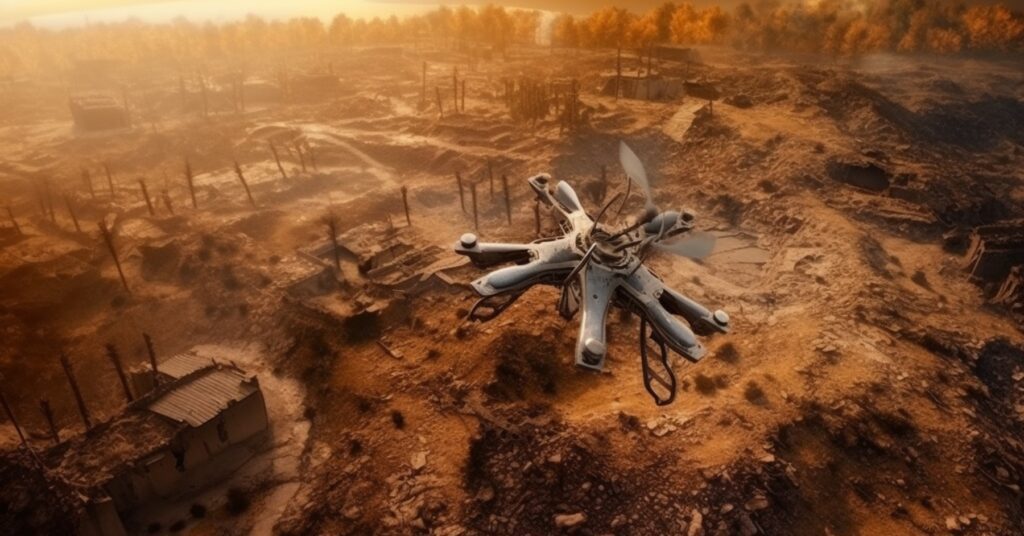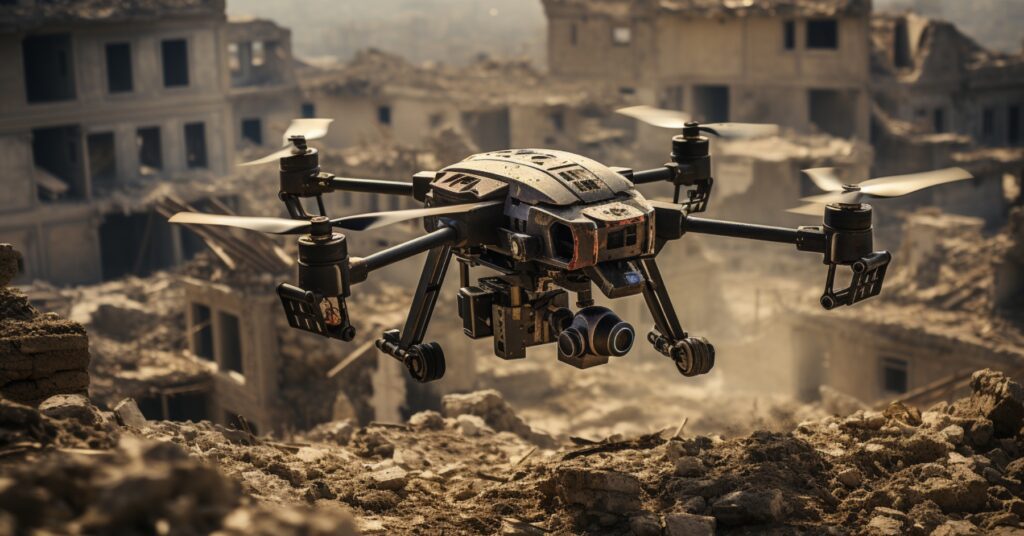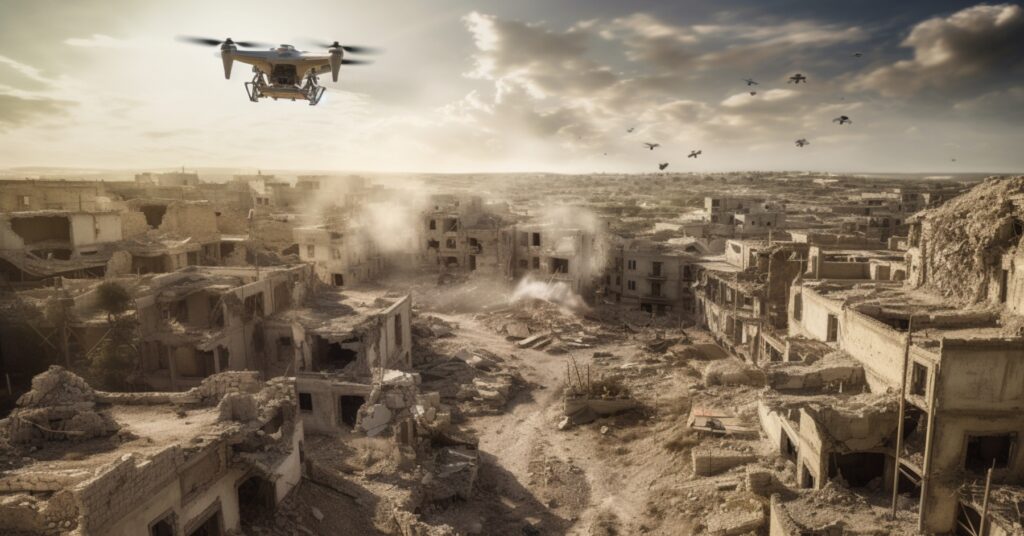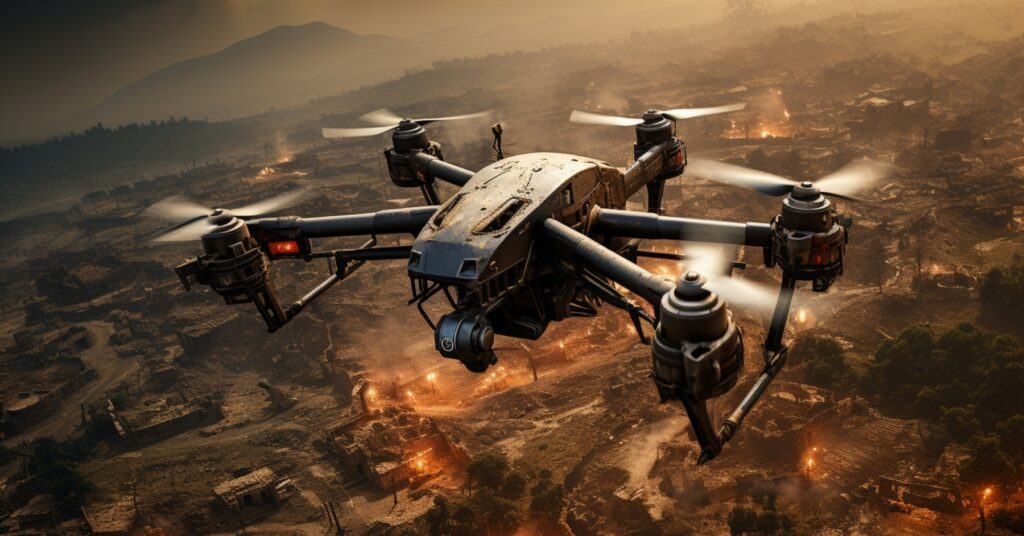Ukraine-Russia Conflict Unveils a New Era”
Jump to Sections
Introduction
Consumer Drones are playing a vital role in the Ukraine-Russia conflict. With their unprecedented use in both reconnaissance and combat operations, consumer and DIY drones are transforming the landscape of modern warfare.
With a $500 consumer drone, a soldier can spot targets miles ahead or drop grenades with pinpoint accuracy. But they raise risks like lack of oversight, accountability, and coordination. Still, Ukraine embraces these flexible funding channels for consumer drones and other tech.

The Transformation of Warfare
According to a report by The Economist, the Ukrainian military has been using 3D printing technology to manufacture their own drones, which are cheaper and more effective than those available on the market. The report also highlights that Ukrainian soldiers have been using these consumer drones to gather intelligence on enemy positions, as well as to carry out targeted strikes against Russian forces.
In addition to this, ABC News reports that Ukrainian soldiers have been using DIY weapons, including consumer drones, to fight against Russian-backed separatists in eastern Ukraine. These weapons are often made from scrap metal and other materials found on the battlefield, making them cheap and easy to produce.
The use of consumer drones has also led to an increase in electronic warfare tactics aimed at disrupting drone operations. According to BBC News, both sides have been using electronic jamming devices to interfere with each other’s drone operations. This has led to a cat-and-mouse game between the two sides, with each trying to outsmart the other.
As the conflict unfolds, it is clear that consumer drones will continue to play an increasingly important role in the battlefield.
- Drones are democratizing warfare. In the past, only militaries with deep pockets could afford to deploy drones. But today, thanks to the rise of consumer drones, even small and poorly funded militaries can have access to this powerful technology. This is a game-changer, and it is leveling the playing field in warfare.
- Drones are changing the battlefield. Consumer drones are giving militaries new ways to conduct reconnaissance, gather intelligence, and deliver weapons. They are also being used to swarm enemy targets and overwhelm their defenses. This is changing the way that wars are fought, and it is creating new challenges for militaries around the world.
- Drones are forcing militaries to adapt. Militaries need to develop new strategies and tactics to protect their drones and counter enemy drone operations. They also need to invest in new electronic warfare technologies to disrupt enemy drone operations. This is a costly and challenging process, but it is essential for militaries to stay ahead of the curve in the consumer drones revolution.

Dominance of DJI in the Market of Consumer Drones
DJI drones dominate the battlefield, despite security concerns
Chinese drone giant DJI holds a monopoly – an estimated 74% share of the global commercial drone market. And its off-the-shelf drones are now ubiquitous on both sides of the war in Ukraine.
Ukraine’s digital forces employ DJI models for recon and targeting Russian assets. Russia uses them to spot and strike Ukrainian troops.
DJI’s civilian drones offer advanced AI tech and high-def cameras at consumer prices – key for cash-strapped militaries. The bestselling Mavic 3 retails for just $1,599.
Competitors like Parrot and Autel lag far behind DJI’s tech and market lead.
And Chinese production keeps costs low. DJI can churn out drones at scale in Shenzhen while pushing the price/performance envelope.
But security experts warn of risks in military reliance on a Chinese brand:
- DJI could share user data with China
- It could disable drones remotely
- The software could have vulnerabilities
The US Army banned use of DJI drones in 2017. And the company remains locked out of government contracts. But pricier US-made alternatives like Skydio struggle for traction. For now, DJI’s unrivaled value continues to trump security fears.
That leaves militaries worldwide dependent on Chinese drones – including those currently at war with each other.
So while combatants fight on the ground, money keeps flowing back to DJI’s coffers in Shenzhen.
Crowdsourcing Funds and Donations
Ukraine’s military lacks advanced drones. But crowdsourced donations are flooding the country with commercial quadcopters. The nimble crowdfunding networks offset Ukraine’s lack of drone production capacity compared to Russia. They also let Ukraine tap global sympathizers for direct military aid – circumventing cumbersome government processes.
According to a report by AP News, the Ukrainian government has been leveraging digital marketing tools and crowdfunding initiatives to keep global attention focused on its war efforts against the Russian invasion.
The United24 campaign, launched by the Ukrainian Embassy in Prague, enables individuals to contribute directly to the acquisition of weapons for Ukraine. The campaign has seen significant success, with donations totaling around $27 million over a recent seven-day period.
The support for Ukraine’s defense efforts extends beyond financial contributions. Regular citizens also directly fund and ship consumer drones to Ukraine through online campaigns.
Ukrainians have been actively involved in crowdsourcing initiatives since at least 2014, raising money online for volunteers fighting Russian-allied forces in the country’s eastern region. The Bloomberg article highlights how businesses, civic groups, and citizens have come together to replenish arms on the front lines and boost morale.
The self-reliance demonstrated by ordinary Ukrainians reflects their response to decades of corrupt and ineffective governments. It has become institutionalized as they grapple with internal uprisings and conflicts with Russia. The domestic aid provided by hundreds of businesses, thousands of civic organizations, and millions of individuals plays a vital role in supporting Ukraine’s defense efforts.
It’s a case study in how decentralized online networks can rapidly equip a technologically-outmatched insurgent force.

The Arms Race in Electronic Warfare Tactics
The rise of consumer drones has led to an arms race in electronic warfare tactics. Both Ukraine and Russia have developed countermeasures to disrupt enemy drone operations. Electronic jamming, signal interception, and other tactics aim to neutralize the effectiveness of drones. The conflict has become a testing ground for innovative electronic warfare strategies.
Russia deploys truck-mounted jammers that can disable drone communications up to 30 miles away. Its forces use R-330Zh Zhitel systems to jam GPS signals, causing drones to lose navigation. And Russian hackers even hijacked Ukrainian consumer drones mid-flight using spoofed signals.
Ukraine responded with its own arsenal of electronic warfare tactics. According to a report by CNN Politics, the US government has approved $113 billion in aid to Ukraine since the Russian invasion in 20221. The aid has been spent on various defense mechanisms, including sophisticated electronic warfare tactics that can neutralize the effectiveness of drones.
Ukrainian military builds custom anti-drone rifles that fire radio pulses to down nearby drones. Ukrainian IT specialists hack the firmware of captured Russian drones to gain remote control. Ukraine also gets access to advanced US electronic warfare equipment like the AN/ALQ-221 radar jammer.
The electronic arms race turns Ukraine into a proving ground for new drone and counter-drone cyberweapons. It offers a preview of the future face of conflict – a battle not just to control drones but the electromagnetic spectrum itself.

Controversies and Concerns
DJI’s China origins drone dominance raises security alarms despite lack of alternatives
Experts warn DJI could feed data to China or remotely disable the drones. The US Army banned DJI use over similar concerns since 2017.
A damning 2020 Pentagon report found DJI drones uploaded sensitive data without warnings. It labeled DJI a potential “cyber espionage threat”.
There are also fears of deliberate vulnerabilities. Founder Frank Wang said DJI is “completely separate” from the government, but doubts linger.
Despite the security risks, Ukraine and allies keep funnelling DJI consumer drones to the front lines. Affordability and performance trump fears. A top-notch DJI Matrice 300 runs just $10,000 – far cheaper than US drones.
Competitors like Skydio lack DJI’s camera quality and flight time. And they’re designed for commercial rather than combat use.
For now, no other brand matches DJI’s combination of cutting-edge tech and mass manufacturing scale.
That leaves Ukraine reliant on Chinese consumer drones, despite the cybersecurity nightmares they could bring. It illustrates how dependency on foreign consumer drone tech creates strategic vulnerabilities, even among US partners.
Until homegrown alternatives can compete on price and quality, buyers may be forced to stomach the espionage risks.
Epilogue
The Ukraine-Russia conflict is showcasing the next generation of warfare, with consumer drones playing a prominent role. On the other hand, the Israel Defense Forces (IDF) are pioneering the use of artificial intelligence (AI) to revolutionize their military tactics.
The advancements in drone and AI technology are ushering in a new era of warfare. As technology continues to develop, it is likely to have an even greater impact on the way that wars are fought in the future.
The widespread use of consumer drones and AI in warfare raises a number of important questions. For example, how will these technologies impact the balance of power between different militaries? How will they change the nature of armed conflict? And what are the ethical implications of using these technologies in war?
These are complex questions that require careful consideration. However, it is clear that drones and AI are transforming warfare, and militaries around the world will need to adapt to this new reality.
Key Takeaways
- The ongoing Ukraine-Russia conflict witnesses the first extensive use of consumer and DIY drones in warfare.
- DJI, a Chinese drone company, dominates the market and is widely adopted by both sides.
- Private initiatives, along with an arms race in electronic warfare tactics, shape the battlefield.
- Despite controversies and concerns, no viable alternatives match the affordability and accessibility of DJI drones.






